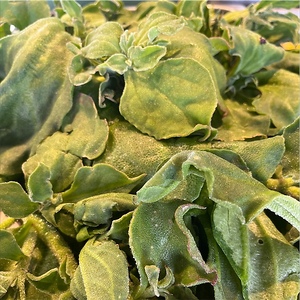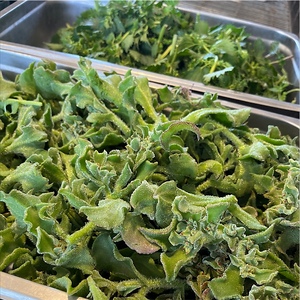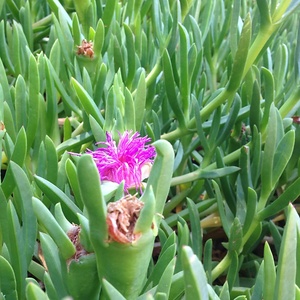


Ice Plant
Estimated Inventory, lb : 0
Description/Taste
Ice plant grows in dense mats with stems that spread out horizontally over the ground. The tightly packed three-sided leaves are 6-10 cm long and have a succulent appearance. They are yellowish or grassy-green when new, but become rusty-orange with age. Its vibrant blossoms range in color from yellow to magenta and resemble a sea anemone. After the flowers dry and turn brown they shrink back revealing the Ice plant’s forgeable fruit. Fruits are 3-4 cm in diameter with a seed structure similar to that of a fig. Its jelly-like interior is sour and salty with a grassy flavor. When fully ripened, Ice plant becomes sweeter with mild tropical notes. They should be foraged when the fruit’s outer wall yellows and takes on a leathery appearance.
Seasons/Availability
Ice plant grows year-round, with fruit ripening in the summer.
Current Facts
Ice plant is a trailing perennial botanically known as Carpobrotus edulis. Also called Sour fig, Cape fig, Sea fig or Hottentot fig, it actually has no relation to the common fig as we know it. There are six species of Ice plant native to Australia, where it is commonly known as Pigface or Angular Pigface. Due to its sprawling carpet-like structure, Ice plant is often grown along highways for erosion control. It can grow as much as one meter per year and in certain areas is deemed an invasive species.
Nutritional Value
Ice plant is mostly water and therefore a low calorie food. It is rich in vitamins A, B and C, mineral salts and trace elements. The juice of Ice plant leaves has antiseptic properties that may be used topically for infections or taken orally for digestive problems. The astringents in Ice plant can seal damaged blood vessels and may be used to treat minor cuts.
Applications
The fruit of Ice plant may be eaten raw, dried or preserved as a jam. The outer green membrane is highly astringent and should be removed. The inner pulp can be extracted simply by slicing off the top and squeezing out the sticky gelatinous seeds. Ice plant fruit’s thick texture is used to richen salad dressings and sauces.
Ethnic/Cultural Info
South Africans commonly use Ice plant fruit to make jams.
Geography/History
Ice plant is native to South Africa, but today can be found in California, Florida, Australia, England and parts of the Mediterranean. It is a drought tolerant species that grows in full sun on well drained, loose sandy soil or rocky outcroppings.










